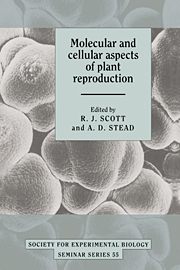Book contents
- Frontmatter
- Contents
- List of Contributors
- Introduction: ‘Where do we go from here?’
- Molecular control of floral organogenesis and plant reproduction in Petunia hybrida
- Control of floral morphogenesis in cauliflower (Brassica oleracea L. var. botrytis): the role of homeotic genes
- Isolation and properties of mutants of Arabidopsis thaliana with reduced sensitivity to short days
- Asexual mutants in Melandrium album (Silene alba): tools in cDNA cloning and analysis of an X/Y chromosome system in plants
- Pollen exine – the sporopollenin enigma and the physics of pattern
- The diversity and regulation of gene expression in the pathway of male gametophyte development
- Characterisation of Arabidopsis thaliana anther-specific gene which shares sequence similarity with β-1,3-glucanases
- Ovule cDNA clones of Petunia hybrida encoding proteins homologous to MAP and shaggy/zeste-white 3 protein kinases
- Towards the elucidation of the mechanisms of pollen tube inhibition during the self-incompatibility response in Papaver rhoeas
- Intracellular movement and pollen physiology: progress and prospects
- Organisation and functions of cell surface molecules on gametes of the brown algae Fucus
- Strategies of flower senescence – a review
- The physiology of petal senescence which is not initiated by ethylene
- Molecular biology of flower senescence in carnation
- Ethylene sensitivity and flower senescence
- Ethylene biosynthetic genes and inter-organ signalling during flower senescence
- Index
Characterisation of Arabidopsis thaliana anther-specific gene which shares sequence similarity with β-1,3-glucanases
Published online by Cambridge University Press: 04 August 2010
- Frontmatter
- Contents
- List of Contributors
- Introduction: ‘Where do we go from here?’
- Molecular control of floral organogenesis and plant reproduction in Petunia hybrida
- Control of floral morphogenesis in cauliflower (Brassica oleracea L. var. botrytis): the role of homeotic genes
- Isolation and properties of mutants of Arabidopsis thaliana with reduced sensitivity to short days
- Asexual mutants in Melandrium album (Silene alba): tools in cDNA cloning and analysis of an X/Y chromosome system in plants
- Pollen exine – the sporopollenin enigma and the physics of pattern
- The diversity and regulation of gene expression in the pathway of male gametophyte development
- Characterisation of Arabidopsis thaliana anther-specific gene which shares sequence similarity with β-1,3-glucanases
- Ovule cDNA clones of Petunia hybrida encoding proteins homologous to MAP and shaggy/zeste-white 3 protein kinases
- Towards the elucidation of the mechanisms of pollen tube inhibition during the self-incompatibility response in Papaver rhoeas
- Intracellular movement and pollen physiology: progress and prospects
- Organisation and functions of cell surface molecules on gametes of the brown algae Fucus
- Strategies of flower senescence – a review
- The physiology of petal senescence which is not initiated by ethylene
- Molecular biology of flower senescence in carnation
- Ethylene sensitivity and flower senescence
- Ethylene biosynthetic genes and inter-organ signalling during flower senescence
- Index
Summary
Introduction
Callase is a complex of β-1,3-glucanase activities which play a crucial role in microsporogenesis. During microsporogenesis, archaesporial cells in the anther give rise to microsporocytes and tapetal cells (Fig. 1). In almost all higher plants a thick wall of callose, β-1,3-glucan polymer, is deposited between the cell membrane and the primary cell wall of the microsporocyte. As meiosis progresses, callose is also deposited along the cellular plates formed during cytokinesis, until each individual microspore is completely encased in callose. The tapetum forms a single layer of cells surrounding the anther locule. The tapetum is an extremely metabolically active tissue and is thought to play a nutritive role in microspore development (Chapman, 1987). Another critical function of the tapetum is the synthesis of callase which is required for the dissolution of the callose walls of the tetrad (Frankel, Izhar & Nitsan, 1969). After the primary and callosic walls of the tetrad have been degraded, the individual microspores are freed into the locule and continue their development into mature pollen grains. The developmental importance of callase activity is illustrated by the occurrence of mutants in petunia and sorghum where callase activity is premature (Frankel et al., 1969; Warmke & Overman, 1972) or delayed (Izhar & Frankel, 1971). These plants are male sterile because the inappropriate expression of callase results in microspore abortion. More recently, work by Worrall et al. (1992) demonstrated that premature secretion of an engineered β-1,3-glucanase from the tapetum of tobacco resulted in partial or total male sterility.
- Type
- Chapter
- Information
- Molecular and Cellular Aspects of Plant Reproduction , pp. 137 - 158Publisher: Cambridge University PressPrint publication year: 1994

